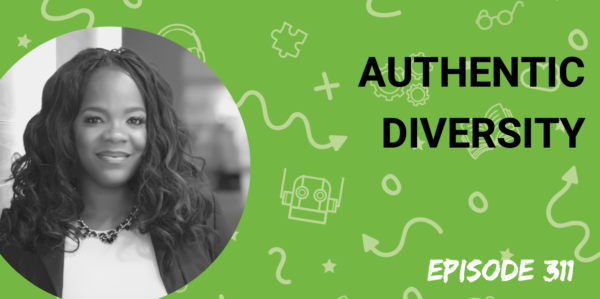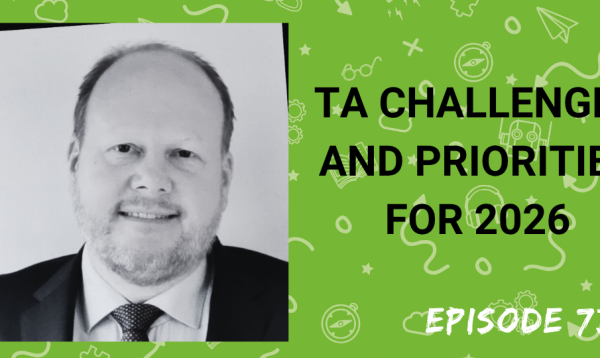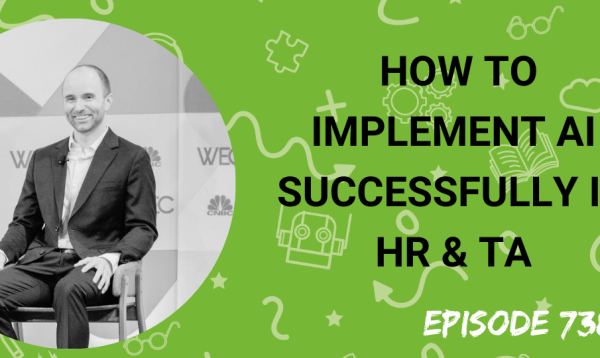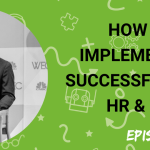2020 has seen more focus than ever before on diversity, equity and inclusion. Despite this though many employers are still struggling to make tangible progress in these areas. So why are diversity strategies failing and how should companies be changing their thinking.
To help answer this question based on her considerable experience and expertise in organisational diversity, my guest this week is Michelle Silverthorn, CEO of Inclusion Nation and author of the book “Authentic Diversity”.
In the interview, we discuss:
• Michelle’s backstory and the reasons she wrote her book
• Why the old rules of diversity don’t work
• The problems with “just making the business case.”
• Talking about race
• Being comprehensive with diversity data
• The importance of prioritising, establishing goals and taking bold actions
• Vital accountability
• Inclusivity and allowing differences to shine
• Michelle’s very powerful personal story about empathy and community
Subscribe to this podcast in Apple Podcasts
Transcript:
Matt Alder [00:00:00]:
Support for this podcast comes from appcast, a leading provider of recruitment, advertising technology and managed services. AppCast helps more than 1500 companies find more qualified candidates using advanced programmatic technology and data driven analytics. With appcast, you’ll effortlessly attract the right talent to your open jobs, helping you save time and money. Find out more about Appcast at Appcast IO. That’s Appcast IO.
Matt Alder [00:00:51]:
Hi everyone, this is Matt Alder. Welcome to episode 311 of the Recruiting Future podcast. 2020 has seen more focus than ever before on diversity, equity and inclusion. Despite this, though, many employers are still struggling to make tangible progress in these areas. So why are diversity strategies failing and how should companies be changing their thinking to help answer these questions? Based on her considerable expertise and experience in organisational diversity, my guest this week is Michelle Silverthorn, CEO of Inclusion Nation and author of the book Authentic Diversity. Hi, Michelle, and welcome to the podcast.
Michelle Silverthorn [00:01:39]:
Thank you so much. Thank you so much for having me.
Matt Alder [00:01:41]:
An absolute pleasure to have you on the show. Could you just introduce yourself and tell everyone what you do?
Michelle Silverthorn [00:01:46]:
I am happy to do that. I am Michelle Silverthorn. I am the founder and CEO of Inclusion Nation. I am a diversity speaker. I’m a diversity trainer. I also run a really great consulting company. I’m an author. I just wrote a book which I can say now is a best selling book in the cutting edge category of hr. So that’s awesome and I am really happy to be here.
Matt Alder [00:02:07]:
Fantastic. Well, it’s brilliant to have you on the show. Could you sort of tell us a little bit about your backstory and how you got to do what you do now?
Michelle Silverthorn [00:02:15]:
So that’s a really great question. Thank you so much for asking that. I grew up in the Caribbean. I grew up in Trinidad and I grew up in Jamaica. I lived there until I was 17. Then I went to Princeton. I went to Michigan Law. After law school, I practiced law for a number of years. But during that time, what I’ve realized and what I realized, and I explained this in my book, is that I didn’t see people like me making it to the top. Right? I didn’t see us in representation. I’m a black woman. I didn’t see people who looked like me in leadership at the partnership levels. When I would look through corporate America, I wouldn’t see that either. And so what I wanted to figure out was why and why that happened and what is the work that we all need to do at every level, from the entry level straight through the C suite to make that. Make that reality no longer the reality. And so I worked for the Illinois Supreme Court for about seven or eight years. I would do a lot of work and trainings and workshops. And what I realized in doing that work when it came to diversity and inclusion is that people want tools. They want to understand what they should do. You know, you can talk about the theory and the reason as much as you want, but let’s actually give people work and advice and practical steps that they can implement. And once we do that, then we can measure success. So after 2018, I left my. I left the court and I started my own company, Inclusion Nation. And I have been going nonstop ever since. I have been traveling. You know, back when we used to travel, I would travel around the country. I would work with all sorts of companies, Fortune 500, lots of law firms, professional services firms, a lot of startups and tech companies, and we really would really dive into the real issues. What I see when it comes to creating spaces of equity in the workplace.
Matt Alder [00:03:55]:
So tell us more about the book. What’s it about and why did you write it?
Michelle Silverthorn [00:04:00]:
So I wrote the book. It was interesting. And, you know, if anyone’s out there ever wanting to write a book, can I just tell you that you absolutely should write a book? You should. You have so many ideas. If you’ve written blog posts, if you’ve been on podcasts, you have all the ideas. So put them to paper, spend three months, write your book. It might not be good on the first draft for the eighth or the ninth draft, you’re really going to get it right. So for me, I had all these ideas that I saw, and as I was looking through, going to all these trainings, doing my own trainings, talking to people, especially talking to people who are marginalized in the workplace. You know, the bipoc employees, the ones who are not, you know, center of the leadership suites. What I realize is that we are living by these old rules of diversity, and we need to replace those old rules of diversity with what I call my new rules of equity. And so I would like, if you read my book, what I talk about are the old rules of diversity that are just exhausting me, and they’re not working. And we keep on implementing training programs and we keep on hiring people to talk about them, and there’s no progress. So, for example. And I won’t go through all of them, but one of the reasons, one of the things I talk about is this focus on just making the business case. If you just make the business case, everyone’s going to buy on. They’ll understand how important diversity is. Folks, we have been making the business case for decades, and our progress is still stagnant. We cannot just make people into widgets. We cannot say, if you hire X, your result will be Y. That might happen, but it’s going to happen because you take a lot of other steps on the way. So that’s one. And the other. One of the other ones I talk about a lot is bias. And we have this whole issue where we don’t talk about. We say bias is fine, we do all these unconscious bias trainings. But as a black woman, I want to tell you what bias feels like to me. As a person who is marginalized in your workplace, I would like you to tell you what it feels like when it cuts me down. I call it the death by a thousand cuts. And how it is so baked into our institutions that it’s hard to change and we have to change them. And then the last old rule I talk about is race. I mean, the last old rule I’ll talk about now is race. And especially in the States, how hard it is for us to talk about race, how hard is this for us to engage in real conversations? And we will use every excuse in the book, right? But we won’t say, you know, what exactly role has race played? We tried to say that we’re colorblind, that we don’t see color. But when you say that, what you’re not looking at is how exactly is the fact that I am black affecting my ability to succeed? And when I say that I’m doing diversity initiatives and I’m promoting women, that’s great, but are you promoting black and brown women? Are you promoting transgender women? How specific are you actually doing? So I really want people to really get specific when it talks comes to identities. So that’s when I talk about the old rules. That’s what I’m talking about. And then in the book, I talk about the new rules of equity, which is really focused on what we can do to change all of that.
Matt Alder [00:06:48]:
Really keen to talk about the new rules of equity and tools and thinking that companies need to move forward, but just to sort of focus on the old rules, just for a second. And I suppose the reason for that is over the last last decade, diversity, inclusion has. Has been a very big topic in hr. It’s something that employers have. Have paid lip service to. It’s something that people Talk about at conferences. And it’s sort of become increasingly clear this year that, that that’s just really ineffective and, and hasn’t moved things forward in the way that we should be moving things forward. Now, you mentioned a few, you mentioned a few things. A few things there. But I wonder if you could just give us your perspective on why employers haven’t. Haven’t moved forward despite the amount of time they spend talking about this.
Michelle Silverthorn [00:07:37]:
You know what’s funny, Matt, is when I, I do a lot of different programs and trainings and exercises and one of the ones I do, it’s called my design Sprints. And I don’t know if anyone’s here. You know, I’m assuming a lot of your listeners are familiar with lean thinking, but one of the approaches I take is that you pick an issue, right? So, for example, the issue is we can’t, you know, we don’t have any black executives. Like that’s an issue, Right. And what I asked them to do is you have to ask why five times. So if your issue is we don’t have any black representation in leadership, ask why. And then the reason we don’t have any black representation in leadership is because we don’t have any in the middle management level. Well, why is that? The reason we don’t have any in the middle management level is because we don’t have that. They don’t have the right access to the work and assignment. The point is, by the time you get to your fifth why, you are going to get to the core of the problem that you have. But here’s where it gets interesting. Whenever I have people do this, you know what the answer always is? It’s because we didn’t prioritize it over and over again. Before George Floyd was murdered here in the States, companies were laying off DEI professionals. They were furloughing them, they were canceling DNI programs. And then George Floyd happens and all of a sudden now we have money for this. We have job postings that we have to fill. We want to prioritize hiring diverse talent, right? What changed? The only thing that changed is that you decided to prioritize it. So that is my very first, and I talk about this as my very first rule. If you as a leader really want to make this a focus, then you have to make it a focus. You have to make it a priority. It needs to come up in every meeting. And once you do that, then you need to do the next step for me, which is you got to look at your data. We are so good at all of our companies at looking at data for everything else. And some of our companies have good diversity data. But what I would like them to do is to look at it at every single level from entry level, like the resumes that you are getting and who are you interviewing, what questions were asked, why people were not allowed to continue, what exactly when you got to the next level, when you talking about what promotions and what assignments and what work, look at all of those. And don’t just look at how people succeed, right? Don’t just look at how the majority succeeds. What I want you to do is look at how the minority does not. What are they not getting access to? And I think that we aren’t doing that either. And the third thing I think that we’re not doing is that we don’t have any goals in mind. We don’t have any targets that we’re trying to hit. And people like to shy away from the word targets, right? Because target sounds a lot like quotas. And we don’t want to do quotas. We don’t have to say that. We got to fill the space, right? I’m not asking you to do quotas. What I am asking you to do is, is to look at your goals. Look at your goals as a business. Look at your goals for recruiting and hiring and bringing in people and tell me, where do you want to go? And once you figure out where you want to go, what are the steps that you are going to take there? Exactly what we do for other business initiatives. And so I will say all of that, and I will just say one last thing, which is why I think we’re stuck. We’re stuck because we’re not taking risks. We’re stuck because we are so focused on what everyone else is doing. And if we do anything that’s different from what everyone else is doing, whether it comes to, to the schools that we recruit at or the hiring criteria that’s used or the networks that we are accessing, or what we’re asking our recruiters to send us, that we’re so scared that we’re going to turn people off in our companies or our name is going to get out there, or, you know, we can’t do this work because we don’t have the executives on board to do it. We have to be brave and we have to be bold. Or again, I’m going to say this again and again, you’re going to come back in 10 years and asking me these exact same questions about why we haven’t gotten Anywhere. And I’m going to tell you the exact same things. We have to figure out, where are we going, why aren’t we there, and what are the more risky actions, the more challenging actions, the bolder actions that we can take. And I’m just going to say this one more last time. That’s just the recruiting aspect of it. We can hire diverse classes. The issue is we aren’t keeping them and we aren’t retaining them. And that’s the other part of the work that we need to do.
Matt Alder [00:11:35]:
And do you think that things are actually changing in 2020? Do you think companies are genuinely prioritizing this and making a difference? Or is it just. Is it just more service?
Michelle Silverthorn [00:11:46]:
Yeah, you know, it’s hard to say. I mean, I’m not going to say it’s hard to say. It depends on the company. And people always ask me, how do we know that this is not just a moment, it’s a movement. And I say the only way you’re going to know that is if you as an employee, you as an HR leader, you as a C suite leader, hold your company accountable. If you as an individual tell, you go to your company and say, okay, you said that In June of 2020 you would commit to these five actions. You said that you believed that, you know, black Lives Matter. You said that we understand that our representation is less diverse than ideal and we want to change that. You said all of that. So what are the steps that we as a company are doing? Who are the leaders who are going to be held accountable to it? I mean, there are companies that are doing that. There are some really great clients of mine that are doing that work, and they have prioritized it and they have put money behind it, and they have put their executive compensation on the line for it. And there are companies that aren’t. And so the only real difference between those companies is really, who are the people who are accountable to this change? How are they actually being, you know, trained and vetted and put in place of positions where they can actually affect change? And so anyone who’s listening to this and they would like to know, how can I ensure that my company follows through on the promises that they made? I’m going to say that’s on you to do that work. You have to do the work of following up on them. We cannot just make sure that only the minorities in our organizations, those who are marginalized, are the only ones doing it. I need every single person to do that work as well.
Matt Alder [00:13:12]:
There’s lots of things I want to talk about and lots of things I want to ask you, but for the sake of, the sake of time, just to zero in on a couple of things. The first one is talent acquisition focus. So we talked about bias, and we talk about unconscious bias and consciousness bias a lot in talent acquisition. What should companies be be thinking? What should they be looking for? And what’s the role of something like recruiting technology in all of this?
Michelle Silverthorn [00:13:40]:
Oh, those are really great questions, man. First of all, what again, again, I want to go back to what I said before. Where do you want to go? So I have so many companies who want to bring me in, and I love doing speeches, I love doing trainings, I love doing workshops. That is what my. What my talent is, getting people on board and getting them the skills they need to change systems. Right? But I need you to tell me what the systems are. Where is the shortfall that you are seeing? So, for example, and again, I talk a lot about black people in the workplace because that’s a lot of the work that I do. If you would like to do some unconscious bias training or put into place bias interrupters, what is the bias that you think you’re seeing when you look at the resumes and the positions and the hiring and the hiring patterns, where is the shortfall that you are looking at? If you cannot share that data with me or with whomever needs to see it, then I’m going to tell you that you don’t know what the problem is that you’re solving. You want to bring in a solution, but you don’t know what the problem is. So first I want you to identify the problem, and then once you do that, let’s figure out where exactly that issue lies. So say, for example, you. So like the CEO of Wells Fargo, for example, had a whole thing where he talked about how they weren’t getting any. The pipeline’s broken. There’s not enough black talent. I hear this all the time. I am not going to dispute him. I have done so online. I will. There are many, many, many, many articles that are out there that explain why what he said was wrong. But let’s say that’s the belief, right? Did you look at your data to support that belief? Are there really a limited number of black resumes that are coming in? Are there really a limited number of black people who are getting through your first level? And if that is the case, that there is a talent short line, a short pipeline that’s shorted out, then how is it that you can intentionally change that? So whether it is the schools that you recruit at and not just the schools. The team that you’re sending to, the schools that you recruit at, the image that you are sending about your company, the leaders that you are sending, what kinds of questions are they asking, the connections that you are making with. And again, we’re talking about black people. What connections are you making with the black student groups? What connections are you making with your employees who are black, who have come from these schools in the States? A lot of people want to recruit at HBCUs. That’s great. But there are thousands of black kids who don’t attend HBCUs and who also may not attend the 12 or 14 schools that you want to recruit at. Try and making connections with those as well. So again, I think it’s a matter of being intentional. It’s a matter of prioritizing it and it’s a matter of setting out what are the goals that you’re putting into place and how are you going to meet those goals and then how will you measure success? I think technology is great, right? I think technology, if you can eliminate whatever biases, especially at the entry level, and that’s wonderful. If you can have resumes that come in that are scrubbed of identifying characteristics, that’s great if that is the problem that you are having, right? So that’s two parts of it. One, I think technology is great if we want to really create bias free atmospheres for the initial review process. And then at the end of the day though, they’re still going to have to meet somebody, right? They’re still going to have to come in. But at least we’ve gotten past those initial barriers, those initial hurdles. There are so many studies that will talk about how we don’t, you know, take in resume, the exact same resume if it has a black name and a white name, the white name will get far more callbacks and depends on the country, right? Black names or Southeast Asian names or Greek names, depending on Canada or Australia or the States or the uk. So if we can have a system that will say, okay, I’m going to scrub that and take off those identifying characteristics, that’s fine. Still though, that person is still going to come in and they’re still going to talk to someone and they’re still going to meet someone and that person, who they meet, we have to understand what biases is that person bringing to the table and what is the technology, if there is a technology that can help counter those biases. So I love that. The only ask I have of the technology And I will have this every time, is that whatever technology is being created, you have to ensure that that technology is bias free as well. Right. When you look at so many of the studies on AI and technology and the bias that exists, and you look at who is creating the technology, who is developing it, they’re bringing in their own biases as well. They’re bringing in their own assumptions. Is it a good thing that we scrub resumes of all identifying characteristics that make me as an individual, who I am? I don’t know. Right. I mean, how is that, is that great that we tell people that you can take away all of who you are as an individual and then all we’re going to leave are the credentials and that’s all we’re going to look at? I don’t know if that’s really the best way to create a workplace that’s inclusive of difference. So I want people to really understand that technology can serve a purpose, whether it’s looking at the job postings and making sure that you eliminate any biased words or biased phrases, if it’s, you know, trying to find spaces in LinkedIn or on Facebook where you can send out your job postings. But please be aware that when I talk about authentic diversity, I am talking about the fact that, that we need to have workplaces that are inclusive of difference, that don’t just exclude them at the door.
Matt Alder [00:18:35]:
Absolutely. And that really comes to the second point that I was going to make. This isn’t just about recruitment. It’s also about retention. How, how can workplaces be more inclusive? What can employers do? What, what mistakes are they making?
Michelle Silverthorn [00:18:51]:
For me, and this is, you know, this is both my last old rule and this is my, my, my last new rule. Right. What I want employers to recognize is that if you are going to hire diverse people, you got to let them be diverse. You have to let them use their values and their differences to influence the way that work is done, instead of trying to build workplaces that they were 100 years ago and then just kind of changing a little bit of things there and here. What we need to create are cultures that allow people to, in how they run project teams, in how they receive and deliver feedback, in how they work with external clients or external, you know, external vendors, in how they can communicate across their teams. When you think about, and this is what I usually say, it comes down to each person as a leader of their own teams. As a leader of your own team, are you ensuring that how people communicate, how they work, how they deliver feedback, the values that they bring all that stuff that I just said. Are you allowing differences to shine? Are you allowing them to influence the way work is done? Or are you expecting folks to assimilate? Because if that’s the case, and I have to keep on wearing a mask every single time I walk in the door, and that mask was never designed to fit me. And that mask was created before someone like me was even allowed in the room, then I’m going to leave. And we see this again and again. When you look at the stats, you have so many diverse professionals who go to one place for three years and they leave. They go to another place for four years and they leave, and we keep leaving. And when we say that we don’t have the talent pipeline to bring the people into management, that’s because we were never putting into place the systems that would allow us to stay. So this is my ask, please train your leaders, train your managers to understand how to recognize cultural differences, value differences, how to recognize different ways of working and speaking and talking and communicating, and then do the work to make those differences matter. It’s a hard ask, my friends, but if we really want to make diversity matter for good, then that’s the work that we have to do.
Matt Alder [00:20:48]:
So as a final question, you talked about whether this was a moment or whether this was a movement. Are you optimistic for the future? Do you think things are really going to change in the workplace?
Michelle Silverthorn [00:21:00]:
You know, I. I will tell a story. I tell it in my book, and I’ll share it with y’all here. When I tell people, when I do my programs, I give them the three reasons I do this work. And I talk about two of them in my book, which is a young black woman named Jasmine. And a lot of the stories I share are stories that she would have experienced. I talk about Trayvon Martin, and he’s the second reason I do this work. And recognizing that if I’m really going to have people listen to what it feels like to be black, what it feels like to be someone who is not in the majority, I want to share them with them, my stories and the stories of so many other people. But the third reason I do this work is because I took an airplane flight and I had. My wallet was stolen, and I was 17 years old, and I was coming back to. Going back to school, going back to Princeton, and I had no idea how I was going to get back to school, right? Because I had no money. I had no wallet, I had no cell phone. My mother was living in Botswana. All these things were happening. And so I’m sobbing and I’m sitting on that plane. And the pilot comes on the intercom and apparently gets. The flight attendant told him what was going on. And he says to everyone in the intercom, this is going to be a great flight. But it’s not going to be a great flight for one person. You see, her wallet was stolen and she’s just trying to get back to school. And I know if you were her mom, you’d want her to get back safely. And so I’m going to pass around my pilot’s hat. And if you could put any money in it for her, I want to be able to tell her mom that we got her back safe. And he absolutely did that. And that plane raised $300 for me. And the reason I tell this story is because that’s the reason I wake up every day. If I did not believe that the people listening to this right now, the people listening to me, the people reading my book, wanted to commit to empathy and community and respect and equity and creating a space where we can actually care about the person who is next to us and recognize that their life has value and their career has value, and they deserve to belong and succeed and they deserve to matter, too. That is the reason I do this work, because I want everyone to believe in this. That’s why I call my company Inclusion Nation, because I genuinely believe that if we can focus on that empathy, if we can focus on that respect and that mutual values, that your values matter just as much as mine do, then we can create a workplace where we transform this reality into something better, where people who look like me and people who look like you and people who don’t look like either of us are allowed to succeed, too.
Matt Alder [00:23:21]:
Michelle, thank you very much for talking to me.
Michelle Silverthorn [00:23:24]:
Thank you so much for having me.
Matt Alder [00:23:26]:
My thanks to Michelle Silverthorn. You can subscribe to this podcast in Apple Podcasts on Spotify or via your podcasting app of choice. Please also follow the show on Instagram. You can find us by searching for Recruiting Future. You can search through all the past episodes@recruitingfuture.com on that site. You can also subscribe to the mailing list to get the inside track about everything that’s coming up on the show. Thanks very much for listening. I’ll be back next time and I hope you’ll join me.








